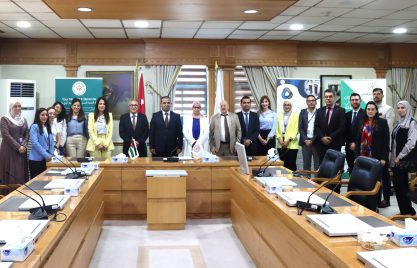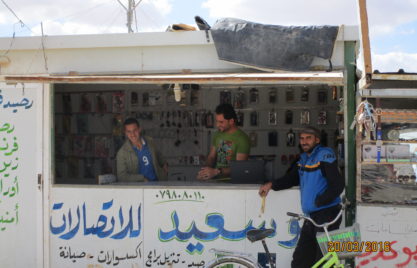The Central Bank of Jordan set ambitious goals for reforming the financial sector for the benefit of people and businesses. While financial institutions are encouraged to expand adequate services for the public, more so digitally, research suggests that only one in four adults is capable of using them wisely. Financial education must gain a strong foothold for future generations to thrive economically and a flagship program holds promise for that.
Financial decisions have tremendous impacts on lives. Financial services allow individuals to start a business, send money to remote family members, and manage household and future expenditures as well as risks. On the contrary, failing to save for old age or emergencies can entail impoverished livelihoods and taking out a loan with inadequate conditions may result in financial distress.
Decisions in the domain of finance can be a daunting task. For people to make the most of the opportunities at hand, it is vital that policymakers and actors from academia and the civil society provide them with the means to enhance their financial literacy, the ability to understand basic financial concepts such as inflation, interest and insurance.
Why low financial literacy can have disastrous effects
Low financial literacy levels expose people that use financial services to higher risks, since they may neither be able to assess properly their own needs nor the conditions of financial products offered to them. This may lead to mediocre decisions with negative implications on the livelihood of people and families. For example, short-term credit users may not understand the speed at which interest rates and repayment schedules can inflate total amounts owed, potentially leading to over-indebtedness or bankruptcy.
Moreover, low financial literacy may not allow potential customers to fully value existing opportunities and services. For instance, a person can save money when switching from an informal to a formal financial service provider, because formal institutions such as banks have more transparent conditions and charge lower interest rates for loans.
Financial literacy and financial inclusion
As the share of adults that use financial services is generally higher than the share of people that are financially literate, financial inclusion rates can obscure low financial literacy rates. Considering the multiple facets of financial literacy a global survey estimates that only around 30% of account owners in emerging economies are financially literate, compared to 57% in advanced economies (S&P Global FinLit Survey 2014). The promotion of access to financial products is only one step among many on a long path to meaningful and sustainable financial inclusion.
Only a fourth (24%) of adults in Jordan are considered as financially literate according to the same survey. Among the regional countries surveyed, only Yemen (13%) and Iran (20%) perform worse. Advanced economies score 57% on average.
New study on financial inclusion and literacy in Jordan
A CBJ-GIZ commissioned study of the state of financial inclusion in Jordan sheds new light on financial knowledge and behavior. For example, it found that inflation is well understood among 87% of respondents in Jordan, yet when it comes to more complex financial concepts, many struggle.
Only around a third of people understand the effect of simple interest on an amount of money or of compound interest (Financial Inclusion Diagnostics Study 2017). Also, only 8% of adults know that their deposits with a bank are protected by the national deposit insurance system – up to JOD 50,000 per depositor. This may result in misconceptions about the outcomes of saving or borrowing money.
When asked about their financial behavior, only 30% of respondents stated that they keep budgets for their household and about half of respondents stated that they regularly compare their actual with their planned expenditures. This indicates that people in Jordan are rather unaware of their financial situation. Interestingly, women perform substantially better in both cases. Circa 38% of women keep a budget compared to 23% of men, and 63% vs. 40% compare planned and actual expenses.
These findings may also explain why many business owners struggle to find access to funding. Confronted with low financial record keeping skills, banks and microfinance institutions may choose to provide credit only at unfavorable conditions or even refuse to provide funds altogether.
What can policymakers learn from these findings? Firstly, empowering people by means of financial education is crucial to unleash the full potential of finance on socio-economic wellbeing. Secondly, educating women bears a multiplier effect in that they have positive effects on their families’ budgets and livelihoods. Thirdly, the strengthening of the financial capabilities of owners of micro and small businesses – major contributors of employment in the private sector – is a priority to increase the prospects of funding.
How financial education may give rise to financially and economically capable generations
Recognizing the importance of lifting financial literacy levels among young people, financial education classes have been gradually introduced in schools across Jordan since 2015 – an initiative led by the CBJ and the Al Hussein Fund for Excellence in close cooperation with the Ministry of Education, the Association of Banks in Jordan, Abdel Hameed Shoman Foundation, and Injaz, a local NGO.
The financial education program as part of the school curriculum will fully cover the grades from 7 to 12 by 2020. The program covers topics such as financial planning and record keeping, banking services and their conditions, taxation, and electronic and mobile payments. This way, young adults are expected to make better decisions when choosing and using affordable and suitable financial products and services that meet their needs – especially digital services such as mobile wallets for value storage or mobile wallet-linked debit cards for payments. They are also more likely to pass on their knowledge to family members.
The effects of the nationwide financial education program in schools will materialize only in the long term, but its positive impact is expected to be of multiple orders of magnitude. This is why its continuous funding must be assured.
Financial education will help to achieve Jordan’s ambitious goals outlined in the National Financial Inclusion Strategy 2018-2020. As part of the plans it developed together with industry representatives including from payments, microfinance and banking for enhancing the widespread usage of responsible and increasingly digital finance by all, the Central Bank harnesses financial capability development as a powerful enabler.
Financially literate Jordanians are more likely to face the horizon of options offered to them with dignity and to use financial services for the benefit of greater social and economic prosperity. We are excited about that generation to rise.
By Atilla Yucel, Julian Kath



